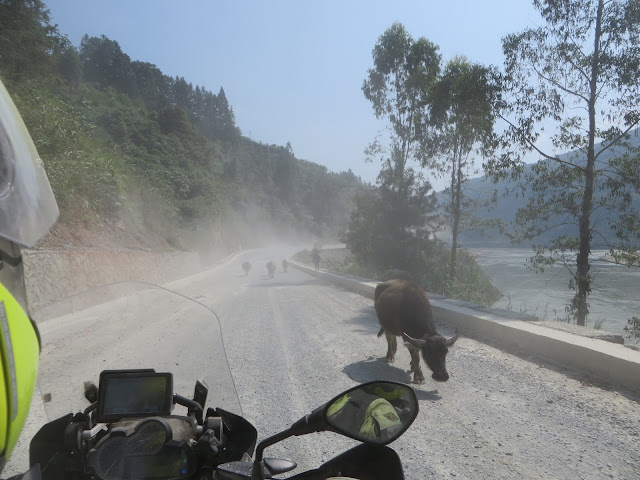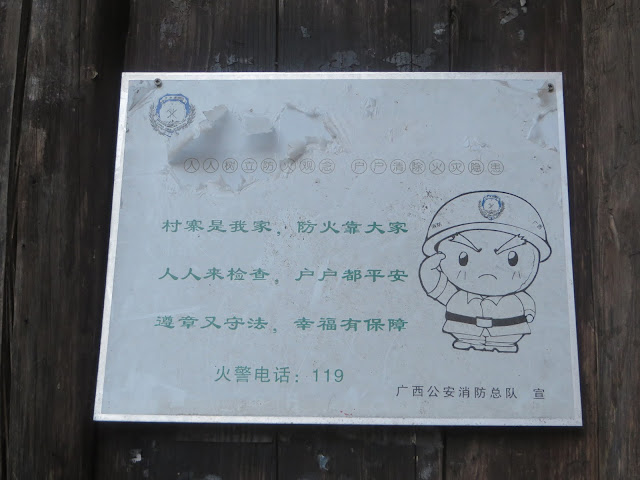Everyone was in a good mood this morning, including tour
leader John. He left the hotel with a
spring in his step.
We met by the nice clean bikes, hoping they would remain clean
through the day. What do you think?
Our morning meeting was brief and we headed out into the
morning traffic. Rongjiang has quite a
morning rush hour..
The city is built along a riverfront and was quite pretty
this morning.
I noticed a building with faded Olympic Game rings on front
of it and a statue of what looked like gymnasts. A quick search on the internet do not yield any further information.
Our first stop was a gas station. Yingchu jumped off the back of John’s bike
and proceeded to convince the station attendants to fill our group of bikes at
the pump.
Trucks passed the back of our motorcycle with less than an
inch to spare.
The opposing traffic was not giving way to allow our side to
progress, anti was one lane ahead, with no flaggers (they don't exist in China - it is every driver for himself).
Finally, Yingchu, Boz
and I got off the bikes and walked up to a the choke point and basically blocked the opposing traffic
just so the motorcycles could get through. We literally stood in from of trucks so they could not move. After David got through, I hopped back onto the motorcycle and we forged
ahead into the 70+ kilometers of construction nightmare that would be our life
for the next three hours.
Not many photos today because of all the dirt and dust.
Occasionally I pulled it out for something really
interesting, like this mining barge,
What an mess! Slippery mud, ruts & deep puddles for miles.
I got back up behind
David and we rode maybe a quarter mile to catch up with Geoffrey and Steve
contemplating the next quagmire. Again I
hopped off and walked to a pick up point.
This was repeated one more time before we hit dry dirt and gravel – for
a while.
Our next obstacle course was over loose rocks. Dave was doing great until we got a little
too close to Steve and hit some big stones.
Dave fought hard, but in the end we went over. Fortunately, Dave only sustained a few
bruises. The padded gear works
well. With some help, we got the bike
back up, and pushed it over to a more compacted area.
Back on the bike, we managed to stay upright through the
rest of the morning'ss ride through a prolonged area of construction at various
degrees of completion.
Our route was along the Dullu River. This is the first time we’ve seen a number of
boats on the water.
The morning snack stop looked so meager, and with more than
half of the construction area still to ride, Dave and I decided to continue on
while the others stopped. This allows us
to go at a slower pace without the pressure of other riders waiting either in
front or in back.
The surface for the rest of the morning varied from hard
pack, dust gravel to loose gravel, to pot holes.
We even had another pile of rocks to climb over. David got stuck up to his axle, but did not
go over. Once again I got off the bike
and this time with the help of a nearby construction worker, while horns were
honking, we picked up the back end so that Dave could slowly work his way
through the pile of rocks. China – what
a country – just dump a pile of rock across the road and hope everyone can make
it through.
The drive did have some points of interest. It’s not everyday you can see a herd of musk
ox ambling down the middle of the road.
Another hydroelectric dam.
This part of China is mainly powered by hydroelectric.
We saw several ferry crossings along the way.
Finally, shortly after noon we came to the end of the
extended construction and onto “good” roads.
In other words, there was still some construction areas, but usually a
kilometer or less.
The roads were good enough for David to get some speed and
have fun around the curves.
About 2:30 in the afternoon we approached the Dong Village
area. Less than 20 kilometers and we’d
be “in the barn”.
So of course, it was time for more road construction. We had ridden ahead of the group, relying on
our GPS to get us to tonight’s hotel. We
pulled off the side of the road to get our bearings. For some reason, the traffic all around came
to stop. No one was moving. We saw an opening in the direction we need to
travel, so after pushing David backwards onto the road, I waited on the other
side of the road while he finished maneuvering the motorcycle. CRASH!
The idiot dump truck driver decided, after looking David in the eye,
that he was going to move forward two feet, although there was no opening in
the traffic. He hit the rear pannier,
knocking David over.
I have to say, there’s nothing like cussing someone out when
you know they don’t understand a word you are saying. The driver got the message, got out of his
cab, and contritely help us get the bike upright. Dave has a sore ankle from the incident, but is able to ride the motorcycle. It could have been worse.
The construction petered out, and we continued on just
“finished” roads, entering the Dong Village area under a pagoda gateway.
Soon we saw our hotel just past a 1916 Chen-Yang wind-rain
bridge.
It is a traditional bridge and
is representative of the Dong ethnic group architecture. It combines corridors, pavilions, pagodas and
attic sturctures. The bridge is built
without nails (we did see some in facia boards) using only wooden tenon joints.
The rest of the group wasn't far behind.
This village thrashes their rice using a machine powered by a foot pedal.
The English translations on the signs are usually quite humorous. Or they have little animae cartoon figures
This one seems to be telling us to only smoke opium in the opium trade place. And the villagers should definitely not have pictures taken with foreign guest by force - heaven forbid! This one gave us quite a few chuckles, but we really should take the Central Office of Spiritual Civilization seriously.
























































No comments:
Post a Comment